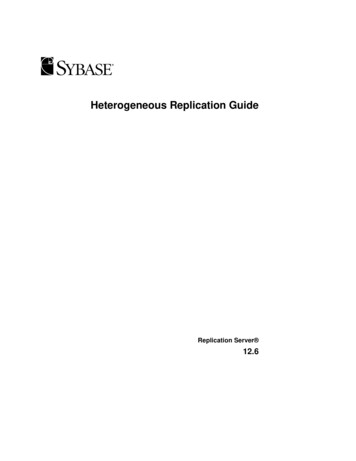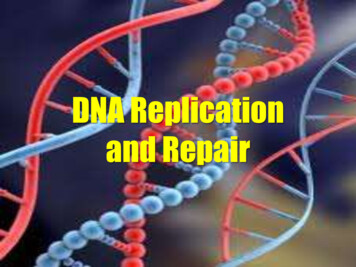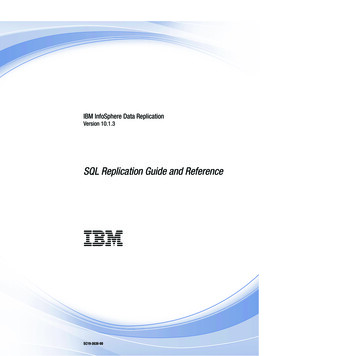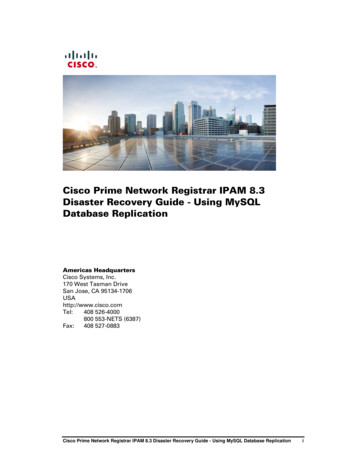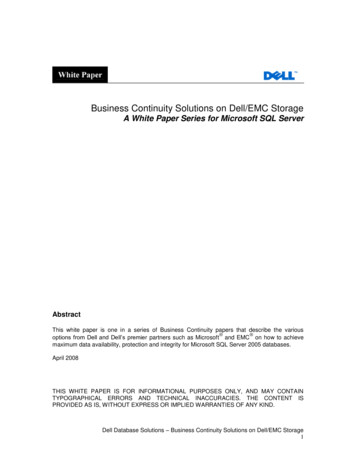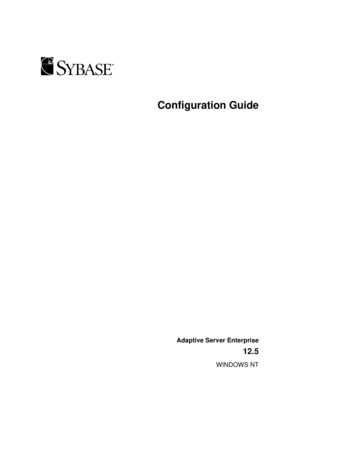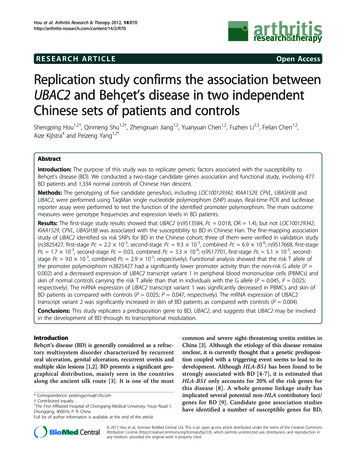
Transcription
Hou et al. Arthritis Research & Therapy 2012, 70RESEARCH ARTICLEOpen AccessReplication study confirms the association betweenUBAC2 and Behçet’s disease in two independentChinese sets of patients and controlsShengping Hou1,2†, Qinmeng Shu1,2†, Zhengxuan Jiang1,2, Yuanyuan Chen1,2, Fuzhen Li2,3, Feilan Chen1,2,Aize Kijlstra4 and Peizeng Yang1,2*AbstractIntroduction: The purpose of this study was to replicate genetic factors associated with the susceptibility toBehçet’s disease (BD). We conducted a two-stage candidate genes association and functional study, involving 477BD patients and 1,334 normal controls of Chinese Han descent.Methods: The genotyping of five candidate genes/loci, including LOC100129342, KIAA1529, CPVL, UBASH3B andUBAC2, were performed using TaqMan single nucleotide polymorphism (SNP) assays. Real-time PCR and luciferasereporter assay were performed to test the function of the identified promoter polymorphism. The main outcomemeasures were genotype frequencies and expression levels in BD patients.Results: The first-stage study results showed that UBAC2 (rs9513584, Pc 0.018, OR 1.4), but not LOC100129342,KIAA1529, CPVL, UBASH3B was associated with the susceptibility to BD in Chinese Han. The fine-mapping associationstudy of UBAC2 identified six risk SNPs for BD in the Chinese cohort; three of them were verified in validation study(rs3825427, first-stage Pc 2.2 10-3, second-stage Pc 9.3 10-3, combined Pc 6.9 10-6; rs9517668, first-stagePc 1.7 10-3, second-stage Pc 0.03, combined Pc 3.3 10-4; rs9517701, first-stage Pc 5.1 10-3, secondstage Pc 9.0 10-3, combined Pc 2.9 10-5; respectively). Functional analysis showed that the risk T allele ofthe promoter polymorphism rs3825427 had a significantly lower promoter activity than the non-risk G allele (P 0.002) and a decreased expression of UBAC2 transcript variant 1 in peripheral blood mononuclear cells (PBMCs) andskin of normal controls carrying the risk T allele than that in individuals with the G allele (P 0.045, P 0.025;respectively). The mRNA expression of UBAC2 transcript variant 1 was significantly decreased in PBMCs and skin ofBD patients as compared with controls (P 0.025; P 0.047, respectively). The mRNA expression of UBAC2transcript variant 2 was significantly increased in skin of BD patients as compared with controls (P 0.004).Conclusions: This study replicates a predisposition gene to BD, UBAC2, and suggests that UBAC2 may be involvedin the development of BD through its transcriptional modulation.IntroductionBehçet’s disease (BD) is generally considered as a refractory multisystem disorder characterized by recurrentoral ulceration, genital ulceration, recurrent uveitis andmultiple skin lesions [1,2]. BD presents a significant geographical distribution, mainly seen in the countriesalong the ancient silk route [3]. It is one of the most* Correspondence: peizengycmu@126.com† Contributed equally1The First Affiliated Hospital of Chongqing Medical University, Youyi Road 1,Chongqing, 400016, P. R. ChinaFull list of author information is available at the end of the articlecommon and severe sight-threatening uveitis entities inChina [3]. Although the etiology of this disease remainsunclear, it is currently thought that a genetic predisposition coupled with a triggering event seems to lead to itsdevelopment. Although HLA-B51 has been found to bestrongly associated with BD [4-7], it is estimated thatHLA-B51 only accounts for 20% of the risk genes forthis disease [8]. A whole genome linkage study hasimplicated several potential non-HLA contributory loci/genes for BD [9]. Candidate gene association studieshave identified a number of susceptible genes for BD, 2012 Hou et al.; licensee BioMed Central Ltd. This is an open access article distributed under the terms of the Creative CommonsAttribution License (http://creativecommons.org/licenses/by/2.0), which permits unrestricted use, distribution, and reproduction inany medium, provided the original work is properly cited.
Hou et al. Arthritis Research & Therapy 2012, 70Page 2 of 8including IL23R [10], CTLA4 [11], eNOS [12], SUMO4[13,14], NOD2 [15], IL1A [16], manganese superoxidedismutase (SOD) [17] and so on. These studies tremendously enhanced our understanding of the genetic etiology of BD. However, these identified risk genes onlycontribute to about 30% of the predisposition for BD[18].Fei and coworkers [19] conducted a genome-wideassociation study (GWAS) on 152 Turkish Behçet’s disease patients using the DNA pooling approach andreported the association of BD with five novel loci/genes, including LOC100129342, KIAA1529, CPVL,UBASH3B and ubiquitin-associated domain containing 2(UBAC2), among which the genetic association betweenUBAC2 and BD was lately confirmed and functional significance was tested by the same study group [20]. Asfar as we know, the association result needs to be confirmed by further replication studies, particularly inother ethnic groups. We, therefore, conducted a candidate association to investigate the association betweenthe identified risk genes/loci and BD in the non-Turkishethnic population. Our result revealed that UBAC2 wasassociated with BD in Han Chinese. Fine mapping andvalidation studies further confirmed UBAC2 as susceptibility gene for Behçet’s disease. Further functional studyshowed that the risk T allele of rs3825427 in UBAC2was associated with the decreased promoter activity andits mRNA expression. These genetic associations andfunctional studies suggest that UBAC2 is a risk gene forBehçet’s disease.Materials and methodsEthics statementWritten informed consent was obtained from each participant, and this study was approved by the ClinicalResearch Ethics Committee of the First Affiliated Hospital of Chongqing Medical University and ZhongshanOphthalmic Center, Sun Yat-sen University (PermitNumber: 2009-201004).SubjectsOne hundred forty-seven BD patients and 951 normalcontrols enrolled in the first-stage were recruited fromApril 2005 to March 2008 in Southern China atZhongshan Ophthalmic Center, Sun Yat-sen University.The replication cohort is comprised of 330 Han ChineseBD patients and 383 Han Chinese normal controls,which were recruited from April 2008 to March 2010 inWestern China at the First Affiliated Hospital ofChongqing Medical University (Table 1). The diagnosisof BD was based on the criteria of the InternationalStudy Group for BD [2]. Twelve patients with typicalnongranulomatous uveitis, multiform skin lesions orgenital ulcers in association with arthritis or other clinical features, were diagnosed as having BD according tothe criteria of the Behçet’s Disease Research Committeeof Japan and were also included in this study (Table 2)[21]. The control populations consisted of unrelatedhealthy individuals from the same geographical regionsas the BD patients and were age, sex and ethnicallymatched with the patients.SNPs selectionWe chose the enrolled 25 SNPs based on the followingprinciple: we focused on the UBAC2 gene and ran Haploview software (Daly Lab at the Broad Institute, Cambridge, MA, USA) using Chinese Han Beijing data toscreen out tagSNPs including rs3825427, rs1927726,rs9517668, rs9554581, rs4636771, rs7332161, rs9517701,rs7325747, rs912129, rs4772190 and also included thereported BD associated SNP rs9513584 [19]. In order toenhance the accuracy rating of genotyping, we alsoincluded 16 SNPs with high heterozygosity (allele frequency 0.1).The three SNPs, including rs3825427, rs9517668 andrs9517701, were enrolled in the replication studybecause of their smaller Bonferroni corrected P-value.The call rate of SNP rs9517699 did not meet the qualitystandard in the replication study (call rate 0.80), soSNP rs9517699 was excluded in the replication analysis(Additional file 1).SNP genotypingGenomic DNA was extracted from the peripheral bloodof patients and controls using the QIAamp DNA BloodMini Kit (QIAGEN Inc., Hilden, Germany) according tothe manufacturer’s instructions. The Genotyping wasdetermined by TaqMan SNP Genotyping AssaysTable 1 Summary characteristic of Behçet’s patients and normal control subjects in this studyCaseControlAnalysisSamples sizeMean age(S.D)Male/FemaleSamplessizeMean age(S.D)Male/FemaleStage IStage II14733032.90 7.5033.39 7.98129/18268/6295138339.77 9.9934.61 7.85712/239301/82Combined47733.07 7.64397/80133437.07 9.111,013/321SD, standard deviation
Hou et al. Arthritis Research & Therapy 2012, 70Page 3 of 8Table 2 The clinical characteristics of Behcet patientsCharacteristicsBD Patientsand 95 C for 15 sec, 60 C for 1 minute, 95 C for 15sec, 60 C for 15 sec.Total (n 477)%Male36275.9Luciferase Reporter AssayFemale11524.1Uveitis477100Oral ulcer46597.5Genital ulcer16735.0Hypopyon11123.3Skin lesionsPositive pathergy test27016756.635.0Arthritis13528.3The whole genome synthesized promoter sequences ofUBAC2 carrying the T allele or the G allele of SNPrs3825427 were cloned into pGL3-basic vector (Promega, Madison, WI, USA). This vector was then transiently transfected into HEK293 cells. Reporter plasmidwas transfected to cells using Lipofectamine reagent(Life Technologies, Grand Island, NY, USA). Transfection efficiency was standardized by cotransfecting withpRL-SV40 (Promega). Luciferase activity was determinedafter 24 hours incubation using a Luciferase Assay system (Beyotime, Jiangsu, China). For each plasmid construct, three independent transfection experiments wereperformed, and each was done in triplicate.(Applied Biosystems, Foster City, CA, USA) on theApplied Biosystems 7500 Real-Time PCR Systemaccording to the manufacturer’s instructions. All SNPstested in this study had a genotyping success rate 98%and accuracy 99% as judged by random re-sequencingof 20% of samples in all subjects.Real-time quantitative PCR analysisAnticoagulated blood samples were obtained usingvacuum tubes with EDTA. PBMCs were prepared fromvenous blood of BD patients (n 8) and normal controls (n 52) by Ficoll-Hypaque density-gradient centrifugation. Skin was obtained from the skin lesions ofpatients (n 4) and the scrotum of normal controls (n 22). Total RNA was isolated from skin and PBMCsof the patients or controls by using the QIAamp RNA Blood Mini kit (QIAGEN Inc., Hilden, Germany)or Qiagen RNeasy Fibrous Tissue Mini Kit (QIAGENInc., Hilden, Germany) with treatment of Dnase I,according to the manufacturer’s instructions andreversed into cDNA according to the Superscript protocol (SuperScript III First-Strand Synthesize System,Invitrogen, Carlsbad, CA, USA). To compare themRNA expression of the two protein-coding transcriptvariants of UBAC2, Real-time Quantitative PCR wasperformed using the Applied Biosystems 7500 System(Applied Biosystems) with the following primers(UBAC2F:5’CCG GCT CCA GTG GGC TCT ACA3’/UBAC2R:5’GGG CGA GCA GGA GGG AGA GG3’)for the UBAC2 transcript variant 1 to generate a 81 bpproduct and (UBAC2F: 5’TAGGAAGTCGTGGCGAGGGAGC3’/UBAC2R: 5’GCCTTGTCTGCTGACCACCGCT3’) for the UBAC2 transcript variant 2 togenerate a 84 bp product. The b-actin (b-actinF:5’GGA TGC AGA AGG AGA TCA CTG3’/bactinR:5’CGA TCC ACA CGG AGT ACT TG3’) waschosen as the internal reference gene to normalizeUBAC2 expression. RT-PCR conditions were one cycleof 95 C for 10 minutes, followed by 40 cycles in whicheach cycle included 95 C for 15 sec, 60 C for 1 minute,Statistical analysisHardy-Weinberg equilibrium (HWE) was tested usingthe chi-square test and no SNPs showed significantdeviation from HWE (P 0.05). Odds ratios (OR) and95% confidence intervals (95% CI) were calculated byusing using SPSS version 17.0 (Chicago, IL, USA) toestimate disease risk. Linkage disequilibrium (LD) wasexamined by using Haploview (version 4.2, Daly Lab atthe Broad Institute, Cambridge, MA, USA). To accountfor multiple testing, the Bonferroni correction wasapplied. Review Manager 4.2 (Cochrane Collaboration,Oxford, UK) was used to perform meta-analysis. Theconditional logistic regression analysis (SAS, 9.13, Cary,NC, USA) was performed to localize the effect and identify the number of independent effects.ResultsThe clinical findings of the BD patients included in ourstudy are shown in Table 2. No statistical difference inthe distribution of age and gender was observedbetween BD patients and controls (P 0.05).The identification of risk gene for BD by candidate genesassociation study in Southern China (first-stage study)Five genes/loci, that is, LOC100129342, KIAA1529,CPVL, UBASH3B and UBAC2, have been identified asrisk factors for BD in Turkish. These five candidategenes/loci were not validated by other ethnic populations. We conducted a candidate gene association studyto confirm the association result using 147 BD patientsand 951 controls. Our results showed that thers9513584 polymorphism inUBAC2 was associated withthe susceptibility to BD (Pc 0.018, OR 1.4, metaanalysis OR 1.5) (Table 3). There was no associationof LOC100129342, KIAA1529, CPVL and UBASH3Bwith BD in the Chinese cohorts (Table 3).
Hou et al. Arthritis Research & Therapy 2012, 70Page 4 of 8Table 3 The meta- analysis result combined our data and Turkish dataSNPNearest gene Risk NRisk allele frequencyControlsCasesP-valuePc valueTurkisha15217066.151.43.0 10-41.5 10-31.8 (1.3 to 2.6)Chinese14795156.553.90.410NS1.1 (0.9 to 1.4)Turkish15217042.726.74.2 10-52.1 10-42.0 (1.5 to 2.9)Chinese14795179.980.00.971NS1.0 (0.7 to 1.4)15214717095125.585.813.284.11.0 10-40.7395.0 10-4NS2.2 (1.4 to 3.3)1.3 (0.9 to 1.9)meta-analysisrs2061634KIAA1529G(9q22)OR (95% CI)Controls1.3 (1.1 to 1.6)meta-analysis1.4 (1.1 to UBASH3BTTurkish15217056.743.41.5 10-37.5 10-31.7 (1.2 to 2.4)Chinese14795161.563.20.590NS0.9 (0.7 to 1.2)Turkish15217044.433.25.8 10-30.0291.6 (1.2 to 2.3)Chinese14795151.442.33.6 10-30.018meta-analysis(11q24)1.6 (1.2 to 2.1)meta-analysisrs9513584UBAC2G(13q32)1.2 (0.9 to 1.4)1.4 (1.1 to 1.8)meta-analysis1.5(1.2 to 1.8)Data from reference 19; OR (95% CI), Odds ratio (95%CI); NS: not significant; Pc: Bonferroni corrected P-valueaFine-mapping study and validation study of UBAC2association in Chinese cohortThe variant in UBAC2 showed a consistent associationin the Turkish and Chinese cohort, therefore, UBAC2was considered as the most important candidate amongthe five loci. We, therefore, fine-mapped the UBAC2using 25 SNPs and found that 6 SNPs, that is,rs3825427, rs1927726, rs9517668, rs9554581, rs9517701and rs9517699, were associated with BD (P 0.05/25 0.002) (Table 4, Figure 1 and Additional file 1). We nextchecked the independence of the evidence for multipleassociations within the UBAC2 locus by carrying out aconditional logistic regression analysis of the 25 SNPs inUBAC2. After control for the genetic effect ofrs3825427, none of the 24 SNPs remained significantlyassociated with Behçet’s disease after correction for thenumber of SNPs tested by the conditional analysis (thesmallest P 0.0024 0.05/25 0.002). Therefore, themultiple associations within the UBAC2 locus are notindependent.To further validate the fine-mapping result, we performed a replication study on the selected three SNPs,including rs3825427, rs9517668 and rs9517701, usingthe West-Southern China cohort. The result showedthat all of the three selected SNPs were associated withBD (rs3825427, First-stage Pc 2.2 10-3, OR 1.5,Second-stage Pc 9.3 10-3, OR 1.4, combined Pc 6.9 10-6, OR 1.5; rs9517668, First-stage Pc 1.7 10-3, OR 1.6, Second-stage Pc 0.03, OR 1.3, combined Pc 3.3 10-4, OR 1.4; rs9517701, First-stagePc 5.1 10-3, OR 1.5, Second-stage Pc 9.0 10-3,OR 1.4, combined Pc 2.9 10-5, OR 1.4; respectively) (Table 4).Effects of promoter polymorphism of rs3825427 onUBAC2 transcriptional levelSince the rs3825427 polymorphism is located in thepromoter region of UBAC2 and bioinformatics analysisrevealed that this G/T SNP changed the binding site fortranscriptional factors, we performed a series ofTable 4 Summary of the association of UBAC2 SNPs with Behcet’s disease in Han Chinese (39.5)rs9517668Trs9517701GSecond-stageAFPcCombined studyPcValueOR 95% CIOR 95% CICaseCtrlValueCaseCtrlValue565(29.7)2.2 10-31.51.2 to2.0248(37.6)231(30.4)9.3 10-31.41.1 to1.7364(38.2)796(29.8)6.9 10-61.51.2 to1.7118(41.5)573(30.1)1.7 10-31.61.2 to2.0230(34.8)219(30.9)0.031.31.1 to1.7348(36.5)792(29.7)3.3 10-41.41.2 to1.6117(39.8)583(30.7)5.1 10-31.51.2 to1.9249(37.7)232(30.3)9.0 10-31.41.1 to1.7366(38.4)815(30.5)2.9 10-51.41.2 to1.795% CI, confidence interval; AF, allele frequency; MA, minor allele; OR, odds ratio; Pc: Bonferroni corrected P-value.AFPcOR 95% CI
Hou et al. Arthritis Research & Therapy 2012, 70Figure 1 Genetic association analysis in UBAC2 gene region.Overview of SNPs across the UBAC2 gene region in the Chinesecohort. Linkage disequilibrium (r2) to the most significantly SNP(rs9517668, red diamond) is color-coded (red: r2 0.8; orange: r2 0.5-0.8; yellow: r2 0.2-0.5; white: r2 0.2). Recombination ratesacross each region in HapMap CHB are shown in light blue (right yaxis). The chromosomal locations and relative positions of genesaccording to hg18 are shown (x axis).functional analyses to examine whether rs3825427 polymorphism affected the expression of UBAC2. We testedtwo protein-coding transcript variants of UBAC2 inmRNA level with the presence of different genotype(TT/GT/GG) in rs3825427. The mRNA level of UBAC2transcript variant 1 was found decreased in PBMCs andthe skin of normal individuals with the TT genotypecompared with those with the GG genotype (Bonferronicorrected P 0.045, P 0.025; respectively) (Figure 2).No significant difference was observed in the expressionof UBAC2 transcript variant 2 between the various genotypes (Figure 2).We subsequently performed a Dual Luciferase Reporter Gene Assay to evaluate whether the promotersequence carrying different alleles have different promoter activity. The promoter sequences of UBAC2 carryingT allele or G allele of SNP rs3825427 were synthesizedby Sangon Biotech (Shanghai, P.R. China). Sequencingwas performed to validate the result of synthesis and theresult showed that only one variant was observed in thelocation of the rs3825427 polymorphism. The luciferasereporter expression was found to be decreased in the Tallele as compared to cells carrying the G allele (P 0.002) (Figure 3).Down-regulated expression of UBAC2 in PBMCs and skinof BD patientsA further study was performed to test whether themRNA expression of UBAC2 was altered in BD. Theresults showed that the expression of UBAC2 was significantly decreased in the PBMCs and skin from BDpatients as compared with that observed in normalPage 5 of 8Figure 2 Comparison of UBAC2 variants transcriptional levelamong different genotypes of rs3825427. Five GG genotype,four GT genotype, three TT genotype PBMCs samples and four GGgenotype, three GT genotype and five TT genotype skin sampleswere used to examine the expression of UBAC2 transcript variant 1and 2 and each sample were assayed three times. The mean SDis given for each genotype from three experiments. Statisticalsignificance was taken when Bonferroni corrected two-tailed P 0.05 using SPSS17.0.controls (P 0.025, P 0.047; respectively) (Figure 4).The mRNA expression of UBAC2 transcript variant 2was significantly increased in skin of BD patients ascompared with controls (P 0.004) (Figure 4).DiscussionIn this study we performed a candidate gene analysiscombined with a fine mapping study and the resultshowed a link of several SNPs in the UBAC2 gene withthe susceptibility to Behçet’s disease in Chinese Hanpatients. Functional analysis revealed that the risk-associated T allele of rs3825427 significantly down-regulatedthe expression of UBAC2 mRNA. A significantlydecreased expression of UBAC2 was observed inPBMCs and skin of BD patients compared to normalcontrols. Our study confirms the association between asingle SNP rs9513584 of the UBAC2 gene and BD,which was recently reported in a group of Turkish BDpatients. Of interest was the observation that the Gallele of rs9513584 was associated with the absence ofeye disease in the study in Turkish patients. We couldnot address this observation since all our patients hadeye disease.The UBAC2 gene, also known as PHGDHL1, islocated at 13q32.3. The UBAC2 gene encodes an ubiquitination related structural domain. The study reportedby Fei et al. [19] and their subsequent replicationshowed the association of UBAC2 gene with Behçet’sdisease and revealed the possible contribution ofUBAC2 in the pathogenesis of BD [20]. Our presentstudy successfully replicated the association between
Hou et al. Arthritis Research & Therapy 2012, 70Figure 3 Effects of the rs3825427 genotype in UBAC2 onluciferase activity in cultured HEK 293 cells. pGL3 luciferasereporter recombinant plasmids containing an UBAC2 promotersequence with the risk allele T or wild-type G allele at SNPrs3825427 were transfected into HEK293 cells. Renilla luciferaseplasmid pTK-SV40 was cotransfected with each construct as aninternal control for normalization. The mean SD is given for eachconstruct from three experiments. Statistical significance was takenwhen two-tailed P 0.05 using SPSS17.0 independent sample t test.UBAC2 and BD in a Chinese cohort. Two other GWASdid not identify the UBAC2 gene as the risk gene forBehçet’s disease [22,23]. The inconsistent result may bepartly explained by the population heterogeneity and theFigure 4 Real-time RT-PCR analysis of UBAC2 transcript variant1 and 2 mRNA levels between Behçet’s patients and normalcontrols. UBAC2 transcript variant 1 and 2 mRNA levels derivedfrom PBMCs of 23 normal controls and 6 patients or from skin of 9normal controls and 4 patients. Each RT-PCR was assayed intriplicate. Significance was examined by using SPSS’s independentsample t test.Page 6 of 8disparate SNP array (Affymetrix SNP array, Santa Clara,CA, USA vs Illumina SNP array, San Diego, CA, USA).In a previous study, we also identified a polymorphismin a ubiquitin-related gene, SUMO4, that was associatedwith the susceptibility to Behçet’s disease in a ChineseHan population [13]. Another ubiquitination relatedgene, UBE2QL1, was also found to be associated withBD in a Turkish cohort [23]. Previous studies suggestthat ubiquitination reactions are involved in the regulation of receptor tyrosine kinase signaling and may playimportant roles in the TNF-a, IL-1b, and TCR-mediatedNF- B activation pathway [24,25]. NF- B has beendemonstrated to play a crucial role in the pathogenesisof BD through regulating the apoptosis-related factorsand increasing the resistance of T cells to apoptosis[26]. All these findings indicate that the ubiquitinationrelated pathway may have a protective effect in thedevelopment of Behçet’s disease.SNP rs3825427 in the UBAC2 gene encodes a promoter polymorphism. Our study showed a close associationof this SNP with the susceptibility to BD. To determinewhether the promoter polymorphism may modulate theexpression of this gene, dual luciferase reporter geneassays and real-time PCR analysis were performed andthe results showed that the T allele was associated withdecreased promoter activity and may down-regulate theexpression of UBAC2. These findings suggest that thers3825427 polymorphism may lead to the down-regulation of UBAC2 expression. More interestingly, UBAC2transcription was found to be down-regulated in PBMCsand skin of BD patients as compared to controls. Ourresults are consistent with that observed in mice deficient in the homologous UBA domain as reported byCarpino et al. [27] They found that UBA knockout miceshowed increased cytokine production and also exhibited an increased incidence and severity of experimentalautoimmune encephalomyelitis (EAE) as compared withwild-type mice [27].Several possible limitations of the present study meritparticular consideration. First, the patients enrolled inour study were recruited from the Eye Department.Because BD usually affects multiple systems, the patientsenrolled in this study might, therefore, represent a separate disease population. Second, the patients enrolled inthe replication study were recruited only from ChineseHan individuals and the sample size is relatively small.The results presented here need to be confirmed inother ethnic populations and using larger samples.Finally, although molecular biology study provides functional evidence for the rs3825427 polymorphism, thisresult is generally suggestive and does not exactlyexplain how the genetic variant translates into physiologic processes and then affects disease susceptibility.Therefore, the association results presented here should
Hou et al. Arthritis Research & Therapy 2012, 70Page 7 of 8be investigated further using more functionalexperiments.Competing interestsNone of the authors has a proprietary or financial interest in any of theproducts mentioned.ConclusionIn conclusion, our study replicated the association ofUBAC2 with BD and identified a promoter SNP ofUBAC2, rs3825427, to be associated with the increasedrisk for BD in Chinese. The functional study showedthat this SNP may be involved in the development ofBD through transcriptional modulation of UBAC2.Received: 2 November 2011 Revised: 7 February 2012Accepted: 29 March 2012 Published: 29 March 2012Additional materialAdditional file 1: The association of UBAC2 gene with Behcet’sdisease and linkage disequilibrium of UBAC2 gene. Table S1presented the association analysis of three SNPs in UBAC2 gene withBehcet’s disease in Han Chinese population. Figure S1 showed linkagedisequilibrium plots of UBAC2 gene based on the HapMap Phase IIdataset for the Han Chinese from the Beijing population by Haploview4.2 software.AbbreviationsBD: Behçet’s disease; EAE: experimental autoimmune encephalomyelitis;EDTA: ethylenediaminetetraacetic acid; GWAS: genome-wide associationstudy; HWE: Hardy-Weiberg equilibrium; LD: Linkage disequilibrium; OR: oddsratio; PBMCs: peripheral blood mononuclear cells; SD: standard deviation;SNP: single-nucleotide polymorphism; SOD: superoxide dismutase; UBAC2:ubiquitin-associated domain containing 2.AcknowledgementsThe samples of patients and healthy controls were partially collected inZhongShan Ophthalmic center, Sun Yat-sen University. Thanks to MsHongyan Zhou and Mr Xiangkun Huang for their assistance in samplecollection and technical support. Thanks to all donors enrolled in thepresent study.This work was supported by the Natural Science Foundation MajorInternational (Regional) Joint Research Project (30910103912), the NationalNatural Science Foundation Project (81070723), the Program for the Trainingof a Hundred Outstanding S&T Leaders of Chongqing Municipality, KeyProject of Health Bureau of Chongqing, the Project of Medical Science andTechnology of Chongqing, the Chongqing Key Laboratory ofOphthalmology (CSTC, 2008CA5003), the Key Project of Natural ScienceFoundation (81130019), the Research Fund for the Doctoral Program ofHigher Education of China (20115503110002) and the Fund for PAR-EUScholars Program. The funders had no role in study design, data collectionand analysis, the decision to publish, or preparation of the manuscript.Author detailsThe First Affiliated Hospital of Chongqing Medical University, Youyi Road 1,Chongqing, 400016, P. R. China. 2Chongqing Eye Institute, Chongqing KeyLaboratory of Ophthalmology, Chongqing, PR China. 3ZhongshanOphthalmic Center, Sun Yat-sen University, Guangzhou, PR China. 4EyeResearch Institute Maastricht, Department of Ophthalmology, UniversityHospital Maastricht, Maastricht, The Netherlands.1Authors’ contributionsHSP carried out the genotyping, Dual Luciferase Reporter Gene Assay andexpression studies and drafted the manuscript. SQM and JZX carried out thegenotyping study. CYY, LFZ and CFL participated in the samples collection.HSP and YPZ participated in the design of the study and performed thestatistical analysis. HSP and YPZ conceived of the study, and participated inits design and coordination. AK and YPZ revised the manuscript. All authorsread and approved the final manuscript.References1. Sakane T, Takeno M, Suzuki N, Inaba G: Behcet’s disease. N Engl J Med1999, 341:1284-1291.2. Criteria for diagnosis of Behcet’s disease. International Study Group forBehcet’s Disease. Lancet 1990, 335:1078-1080.3. Yang P, Fang W, Meng Q, Ren Y, Xing L, Kijlstra A: Clinical features ofChinese patients with Behcet’s disease. Ophthalmology 2008, 115:312-318e314.4. Cohen R, Metzger S, Nahir M, Chajek-Shaul T: Association of the MIC-Agene and HLA-B51 with Behcet’s disease in Arabs and non-AshkenaziJews in Israel. Ann Rheum Dis 2002, 61:157-160.5. Sano K, Yabuki K, Imagawa Y, Shiina T, Mizuki N, Ohno S, Kulski JK, Inoko H:The absence of disease-specific polymorphisms within the HLA-B51gene that is the susceptible locus for Behcet’s disease. Tissue Antigens2001, 58:77-82.6. Kera J, Mizuki N, Ota M, Katsuyama Y, Pivetti-Pezzi P, Ohno S, Inoko H:Significant associations of HLA-B*5101 and B*5108, and lack ofassociation of class II alleles with Behcet’s disease in Italian patients.Tissue Antigens 1999, 54:565-571.7. Mizuki N, Ota M, Yabuki K, Katsuyama Y, Ando H, Palimeris GD, Kaklamani E,Accorinti M, Pivetti-Pezzi P, Ohno S, Inoko H: Localization of thepathogenic gene of Behcet’s disease by microsatellite analysis of threedifferent populations. Invest Ophthalmol Vis Sci 2000, 41:3702-3708.8. Yazici H, Fresko I, Yurdakul S: Beh
tal of Chongqing Medical University and Zhongshan Ophthalmic Center, Sun Yat-sen University (Permit Number: 2009-201004). Subjects One hundred forty-seven BD patients and 951 normal controls enrolled in the first-stage were recruited from April 2005 to March 2008 in Southern China at Zhongshan Ophthalmic Center, Sun Yat-sen University.
